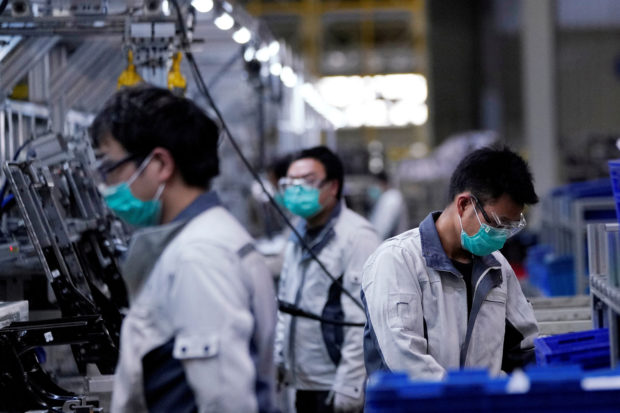China’s July factory activity grows at slower pace – Caixin PMI

Employees wearing face masks work on a car seat assembly line at Yanfeng Adient factory in Shanghai, China, as the country is hit by an outbreak of a new coronavirus. REUTERS/Aly Song/File Photo
BEIJING- China’s factory activity expanded at a slower pace in July, as growth momentum softened in output, new orders and employment, a private sector poll showed on Monday.
The Caixin/Markit manufacturing purchasing managers’ index (PMI) eased to 50.4 in July from 51.7 in the previous month. The reading was well below analysts’ expectations for a slight dip to 51.5.
The 50-point index mark separates growth from contraction on a monthly basis.
China’s major manufacturing hubs, including the commercial hub Shanghai, saw a solid rebound in June from widespread COVID lockdowns in spring, but the recovery has started to fade amid fresh virus flare-ups and weakening domestic and global demand, as well as a prolonged property market slump.
The findings were slightly better than the government’s official PMI on Sunday that showed China’s factory activity unexpectedly contracting in July. The Caixin survey is believed to focus more on smaller, export-oriented companies.
A sub-index for output signaled a second monthly rise, but was noticeably slower than June.
Growth in new orders — domestic and export — also softened due to muted demand and the lingering impact of COVID-19 on client spending.
Due to the recent COVID flare-ups and the lack of stock and staff at suppliers, the time taken for purchased inputs to be delivered to manufacturers increased in July.
Meanwhile, an index for employment at Chinese manufacturers fell for the fourth month in a row and dived to the lowest in 27 months, reflecting continued labor market weakness. Companies attributed the staff shedding to cost cutting, subdued sales and the non-replacement of voluntary leavers.
“The recovery in supply and demand failed to spill over into the labor market for manufacturing, which continued to shrink,” said Wang Zhe, senior economist at Caixin Insight Group.
“Companies, strongly inclined to lower costs in the face of sluggish market demand, were cautious about expanding their staff,” Wang added.
In one bright note, companies’ input costs rose only slightly after relentless price rises that squeezed profit margins. However, they had to cut their selling prices for the third month in a row due to soft demand.
China’s economy slowed sharply in the second quarter, highlighting the colossal toll on activity from widespread COVID lockdowns, which jolted industrial production and consumer spending.
Policymakers have reaffirmed their zero-COVID stance and are prepared to miss their GDP growth target of “around 5.5 percent” for this year, state media reported after the Politburo meeting this week. Authorities will instead focus on achieving the best results this year, a contrast to previous calls that it will work hard to meet its 2022 growth target
Stressing the third quarter will be a crucial period to get the economy back on track, Wang expected no massive stimulus measures.
“Effective implementation of existing policies is a more practical option.”